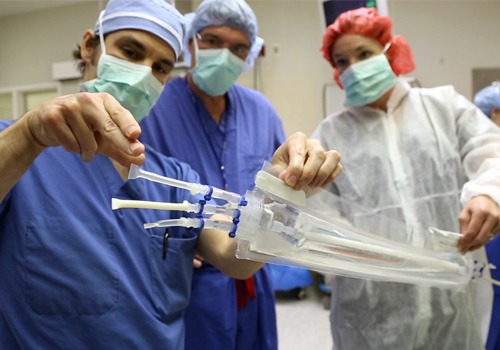
By Jeffrey H Lawson
Recent advances in tissue engineering have led to an investigational off-the-shelf bioengineered blood vessel for implantation and provide vascular access for dialysis patients. The current standard of care for patients with end-stage renal disease requiring haemodialysis includes surgery to create an arteriovenous fistula, placement of a synthetic polytetrafluoroethylene (PTFE) graft, or a central venous catheter. Research shows that up to 50% of patients fail to adequately mature their fistulae after creation and are not suitable for dialysis within five months after surgical placement. Likewise, PTFE grafts are subject to a range of complications, including thrombosis, outflow vein stenosis, infection and high intervention rates to maintain blood flow. Catheters are known to have high rates of infection, inefficient dialysis and are associated with inducing central vein stenosis and occlusion.
Humacyte has developed a novel bioengineered blood vessel that is intended to aid patients in need of dialysis access and vascular replacement throughout the body. Based on preclinical and early clinical data, this technology has the potential to offer an alternative to conventional synthetic vascular prostheses, central venous catheters, and vein grafts, which have served as the standard for access creation and vascular reconstruction in the peripheral and coronary circulation.
The bioengineered blood vessel is composed of extracellular matrix and is similar in strength to native human vein and artery. The method of creating the bioengineered blood vessels utilises human vascular smooth muscle cells, which are cultured in bioreactors in vitro to produce bioengineered blood vessels in the desired length and diameter. Once the cultured cells have made a robust vascular structure, a subsequent decellularisation process is employed to remove cellular material, thereby allowing for administration in an allogeneic manner. Following manufacturing, the bioengineered vessel can be stored in a medical facility, and is accessible for immediate clinical use.
In preclinical studies in pigs, dogs and primates, the bioengineered blood vessels were tested in models of peripheral arterial bypass, coronary artery bypass, and vascular access for haemodialysis. In each of these preclinical settings, the bioengineered blood vessels were durable, well-tolerated and functioned as intended. Furthermore, the mechanical properties of the graft (suture retention) strengthened after implantation and no graft exhibited haemodynamically significant intimal hyperplasia. The human bioengineered blood vessels placed into the upper arm of baboons could be accessed by needle puncture (simulating haemodialysis) and haemostasis was rapidly achieved following needle removal. On histological analysis, the grafts were found to be well integrated into the host and repopulated with native host cells characteristic of native blood vessels.
Humacyte is currently engaged in a multicentre clinical trial testing this bioengineered blood vessel in both the United States and Poland. To date, bioengineered blood vessels have been successfully implanted in 80 patients for vascular access grafts for haemodialysis (60) and lower leg arterial femoral-to-popliteal artery bypass (20). The grafts have demonstrated excellent surgical handling and are easy to sew. Implanted dialysis access grafts have functioned as intended and allowed for cannulation and dialysis. In July 2014, the United States Food and Drug Administration granted the Humacyte “Fast Track” designation for the clinical development of the novel bioengineering technology which is intended to facilitate the accelerated review of this novel vascular bioengineered tissue for dialysis patients in need of arteriovenous access for haemodialysis.
Jeffrey H Lawson is vice chair of Research, professor of Surgery and Pathology, medical director, Clinical Research Unit, Program Director, Resident Research Fellowship, Department of Surgery, Duke University, Durham, USA













